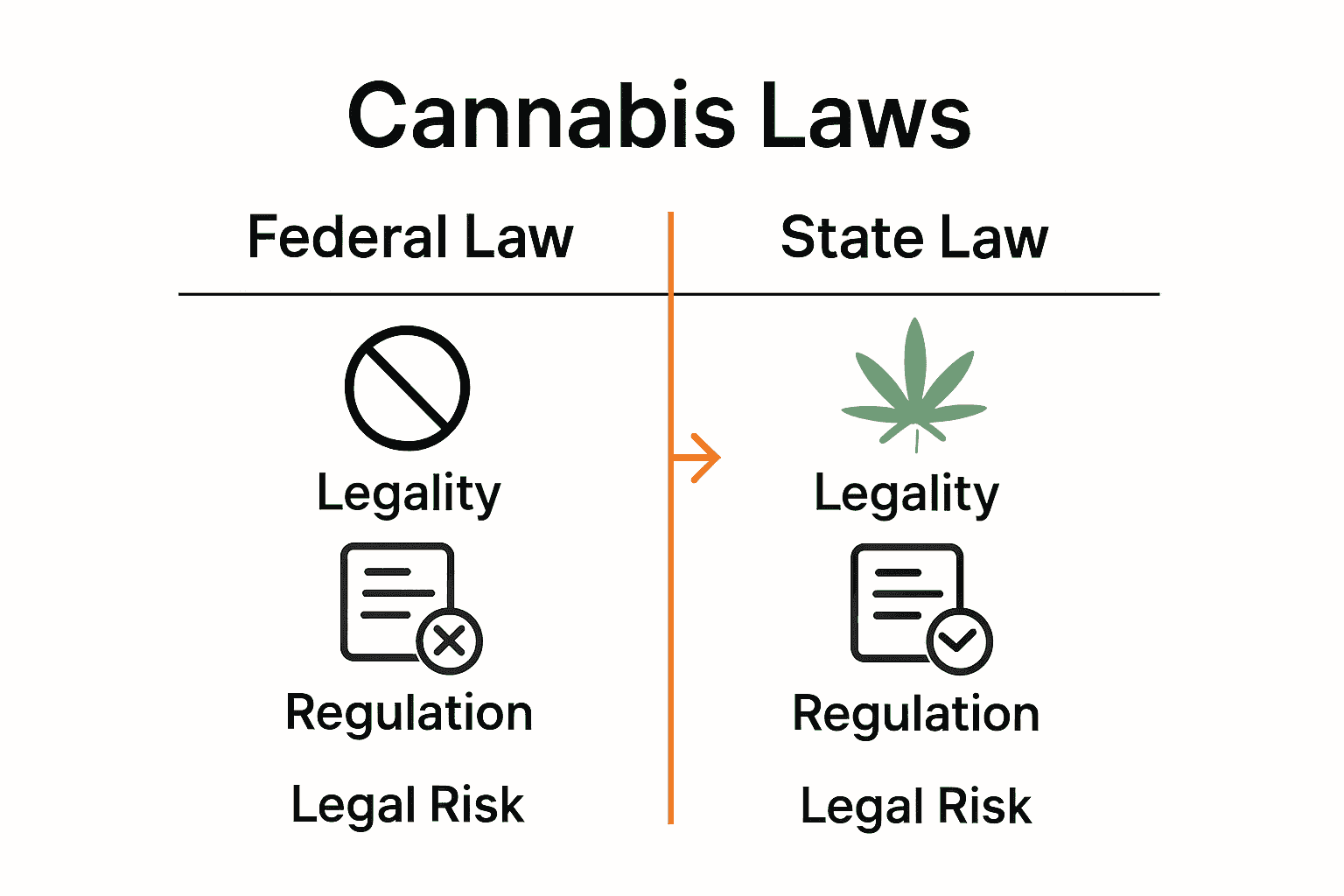
What Is Cannabis Legalization? Complete Overview
More than 40 countries now permit some form of legal cannabis, yet confusion about what legalization really means remains widespread. Changes in cannabis policy do more than alter laws—they impact public health, economic growth, and individual rights. With regulations varying by region and model, understanding the core principles of cannabis legalization helps consumers, businesses, and policymakers make informed decisions in a rapidly shifting landscape.
Table of Contents
- Defining Cannabis Legalization And Core Concepts
- Different Types Of Cannabis Legalization Models
- Federal Versus State Cannabis Laws Explained
- Key Rights And Obligations For Consumers And Sellers
- Risks, Legal Issues, And Market Implications
Key Takeaways
| Point | Details |
|---|---|
| Cannabis Legalization | Represents a shift towards regulating cannabis use and production, focusing on public health and reducing criminal justice burdens. |
| Regulatory Models | Multiple legalization models exist, each with unique implications for access and societal impact, including commercial supply, government control, and social clubs. |
| Federal vs. State Laws | A disconnect persists between federal prohibition and state legalization, necessitating awareness of the legal risks for consumers and businesses. |
| Consumer Rights and Seller Obligations | Clear guidelines outline age limits, purchase restrictions, and safety standards to ensure responsible cannabis use and distribution. |
Defining Cannabis Legalization and Core Concepts
Cannabis legalization represents a comprehensive policy shift transforming how societies approach cannabis regulation, consumption, and production. According to research from Oxford Academic, meaningful cannabis decriminalization creates conditions for establishing a regulated legal model that addresses systemic challenges around drug policy.
Cannabis legalization fundamentally means removing criminal penalties associated with cannabis possession, production, and distribution while establishing a structured regulatory framework. The Cambridge Journal highlights how international cannabis regulations have dramatically evolved since 1925, with contemporary jurisdictions now permitting recreational production, sale, and consumption.
Key characteristics of cannabis legalization typically include:
- Establishing legal age limits for purchase and consumption
- Creating regulated commercial markets
- Implementing taxation frameworks
- Developing quality control and safety standards
- Providing consumer protections
- Reducing criminal justice system burdens
The core objective of cannabis legalization extends beyond mere policy change. It represents a nuanced approach to addressing historical criminalization, promoting public health, generating economic opportunities, and recognizing individual autonomy in personal consumption choices. As cannabis delivery becomes increasingly accessible, understanding these legal frameworks becomes crucial for responsible consumption and community engagement.
Different Types of Cannabis Legalization Models
Cannabis legalization is not a monolithic concept but a complex landscape with diverse regulatory approaches. Oxford Academic identifies five fundamental regulatory models that guide contemporary cannabis policy: public safety, public health, medicinal cannabis, consumer cannabis, and racial justice models.
According to European Union Drugs Agency, jurisdictions worldwide implement four primary models of legal cannabis production and supply:
- Taxed Commercial Supply: Private businesses operate within strict regulatory frameworks
- Government Supply: Direct state control over cannabis production and distribution
- Permitting Home Grow: Allowing individuals to cultivate limited cannabis quantities
- Social Clubs: Cooperative models where members collectively manage cannabis production
Each legalization model carries unique implications for consumer access, regulatory oversight, and societal impact. The public safety model prioritizes strict control mechanisms, while the racial justice model seeks to address historical inequities in cannabis criminalization. Understanding these nuanced approaches helps consumers and policymakers navigate the evolving cannabis selection landscape.
Ultimately, cannabis legalization models reflect broader social values, balancing individual freedoms, public health concerns, economic opportunities, and systemic justice considerations.
As regulations continue to evolve, these models provide frameworks for responsible, equitable cannabis policy development.
Federal Versus State Cannabis Laws Explained
Wikipedia highlights a complex legal landscape where cannabis remains federally classified as a Schedule I drug, creating a significant disconnect with state-level legalization efforts. This federal-state legal tension creates unique challenges for cannabis consumers, businesses, and regulatory frameworks.
The proposed Cannabis Administration and Opportunity Act, as detailed by Wikipedia, represents a potential breakthrough in resolving these legal contradictions. Key distinctions between federal and state cannabis laws include:
- Federal law classifies cannabis as an illegal controlled substance
- Individual states have independently legalized medical and/or recreational cannabis
- State laws cannot override federal regulations
- Interstate cannabis transportation remains legally complicated
Consumers navigating this complex legal environment must understand critical nuances. While some states permit cannabis use, federal prohibition means potential legal risks exist, particularly for activities crossing state lines or involving federal properties. Individuals should carefully research local regulations and contact legal resources when uncertain about specific legal implications.
The ongoing legal evolution suggests a gradual shift towards more unified cannabis regulations. As public opinion and state-level policies continue transforming, federal laws may ultimately adapt to reflect the growing acceptance and regulated approach to cannabis consumption across different jurisdictions.

Key Rights and Obligations for Consumers and Sellers
California Proposition 64 provides a comprehensive framework illustrating the intricate balance between consumer rights and seller obligations in cannabis legalization. This legislation establishes critical guidelines that help define the boundaries of legal cannabis consumption and commercial distribution.
Key consumer rights and seller obligations typically include:
- Age Restrictions: Consumers must be 21 or older to purchase cannabis
- Purchase Limits: Maximum quantity restrictions for individual transactions
- Licensing Requirements: Sellers must obtain specific state-issued commercial cannabis licenses
- Product Safety Standards: Mandatory testing and quality control regulations
- Taxation Compliance: Specific tax structures for cannabis sales
Germany’s Cannabis Act further demonstrates how legal frameworks create nuanced responsibilities for both consumers and sellers. Non-profit cannabis social clubs, for instance, must adhere to strict operational guidelines while consumers gain rights to possession and limited cultivation.
Navigating these complex regulations requires careful attention to detail.
 Consumers must understand local laws, while sellers must maintain rigorous compliance to verify product quality and consumer age. The evolving landscape of cannabis legalization demands ongoing education and awareness to ensure responsible consumption and distribution.
Consumers must understand local laws, while sellers must maintain rigorous compliance to verify product quality and consumer age. The evolving landscape of cannabis legalization demands ongoing education and awareness to ensure responsible consumption and distribution.
Risks, Legal Issues, and Market Implications
PubMed Research highlights six critical lessons that illuminate the complex landscape of cannabis legalization, revealing multifaceted risks and market transformations. The emerging cannabis industry presents a nuanced ecosystem balancing economic opportunities with potential societal challenges.
Key risks and market implications include:
- Regulatory Complexity: Navigating evolving legal frameworks
- Public Health Considerations: Potential long-term consumption impacts
- Economic Disruption: Emerging market dynamics and investment opportunities
- Social Justice Implications: Addressing historical criminalization
- Banking and Financial Challenges: Limited institutional support
De Gruyter Scholarly Research underscores the intricate relationship between the marijuana legalization movement and commercial interests. The cannabis industry represents more than an economic sector—it’s a complex social phenomenon intersecting policy, justice, and market innovation.
Consumers and entrepreneurs must remain vigilant, understanding that cannabis legalization is an ongoing process with significant FDA regulatory considerations. Successful navigation requires continuous learning, adaptability, and a comprehensive understanding of the evolving legal and market landscape.
Discover Legal Cannabis with Confidence and Care
Navigating the intricate world of cannabis legalization can feel overwhelming as you balance legal nuances, quality, and personal wellness goals. This article explores the challenges consumers face in understanding their rights, safe access, and regulatory complexities. At Grade A Dropouts, we simplify your path to premium THC products by offering carefully sourced cannabis strains with transparent information and trusted compliance. Experience peace of mind knowing you are supported in making informed, responsible choices aligned with evolving laws and your natural healing journey.

Ready to explore a curated selection that respects both your health and the law? Visit our Uncategorized – Grade A Dropouts page for latest offerings and insights. Begin your experience today at Grade A Dropouts, where legal cannabis meets exceptional quality and dedicated service. Don’t wait to embrace the benefits of cannabis within a safe and regulated environment.
Frequently Asked Questions
What does cannabis legalization involve?
Cannabis legalization involves removing criminal penalties for cannabis possession, production, and distribution, while establishing a regulatory framework that governs its commercial use.
What are the main models of cannabis legalization?
There are several models of cannabis legalization, including taxed commercial supply, government supply, permitting home grow, and social clubs, each with unique regulatory implications and access structures.
What are the key rights of consumers in a legalized cannabis market?
Key consumer rights typically include age restrictions for purchasing cannabis, limits on the amount that can be purchased at once, and rights to safety standards and product quality assurances.
What are the risks associated with cannabis legalization?
The risks include regulatory complexity, potential public health concerns, banking and financial challenges, and the need to address historical social justice implications linked to prior cannabis criminalization.
